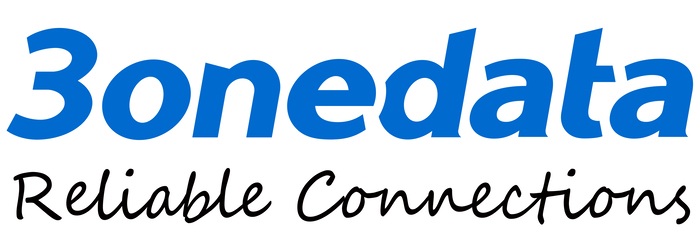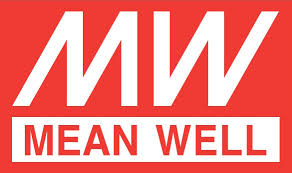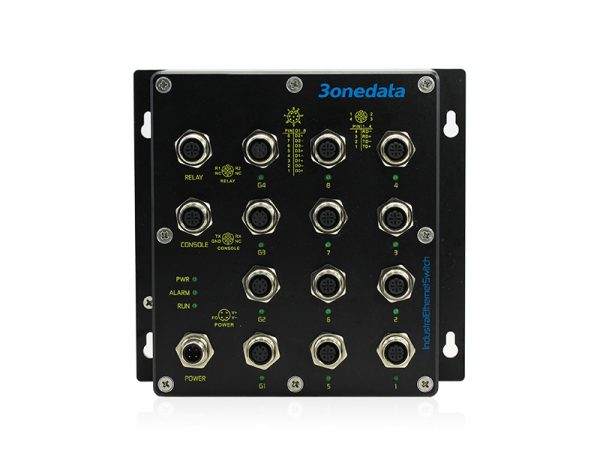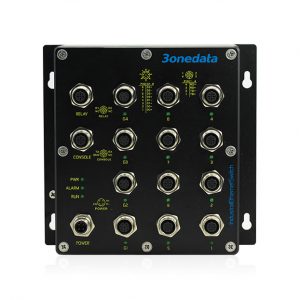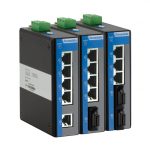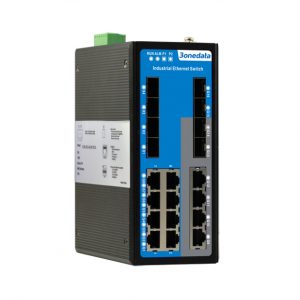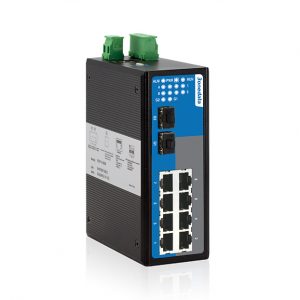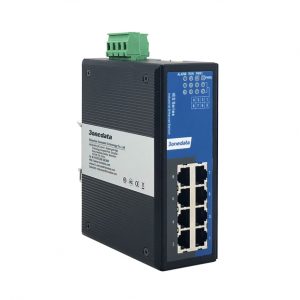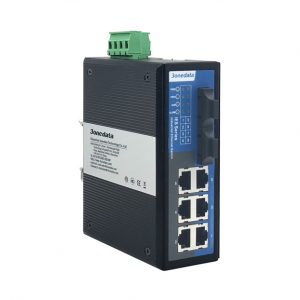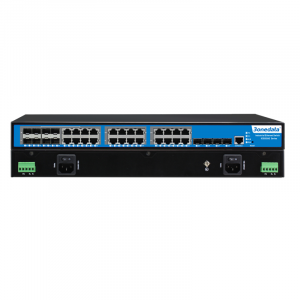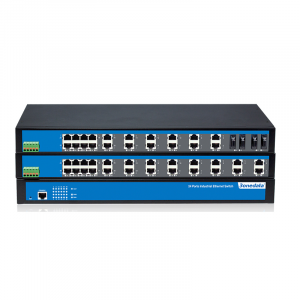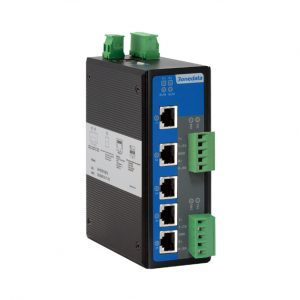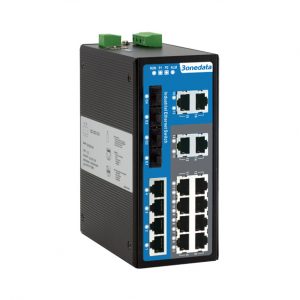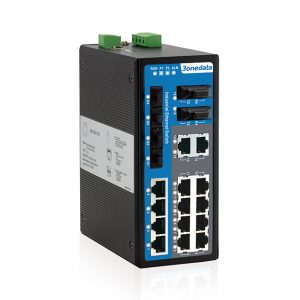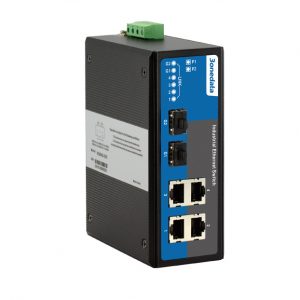TNS5800 Series
EN50155 8+4G-port Layer 3 Managed Ethernet Switches


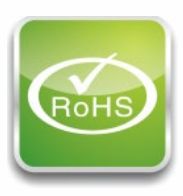


![]()
![]()
![]()
- Support 4 Gigabit M12 (Bypass function), 8 100M M12
- Adopt SW-Ring patent technology, support single ring, coupling ring, chain ring, Dual-homing ring network function
- Support 110 VDC power supply input
- Support -40~75℃ wide operating temperature range
- Applicazioni
- SPECIFICHE
- LISTA MODELLI
- DOWNLOAD
Descrizione
TNS5800 series are 12-port 100M/Gigabit layer 3 managed industrial Ethernet switches designed for rail transit. This series of products conform to EN50155 and EN50121 industrial standards. Ethernet interface adopts reliable M12, which can be used in scenes with strenuous vibration and shock. This series include two types of products and provide Gigabit M12 and 100M M12 interfaces. It adopts 1U rack-mounted or wall mounting to meet the requirements of different application scenes.
Network management system supports various network protocols and industrial standards, such as Static Route, RIP, OSFP, VRRP, BGP, STP/RSTP/MSTP, 802.1Q VLAN, QoS, DHCP Server, DHCP Client, IGMP Static Multicast, LLDP, Port Trunking, Port Mirroring and so on. It also possesses complete management functions, including Port Configuration, Port Statistics, Port IP Binding, Access Control, 802.1X Authentication, Network Diagnosis, Rapid Configuration, Online Upgrading, and supports CLI, WEB, Telnet, SNMP and other access methods. It can provide users with good experience with friendly design of network management system interface, simple and convenient operation.
When the port link failure occurs, ALARM indicator will be bright and send out alarm, meanwhile, alarm device connected to the relay will send out alarm for rapid scene troubleshooting. Hardware adopts fanless, low power consumption, wide temperature and voltage design and has passed rigorous industrial standard tests, which can suit for the industrial scene environment with harsh requirements for EMC. It’s specially designed for rail transit industry and can be widely used in vehicle-mounted PIS, CCTV, Video Monitoring, Train Control and other systems.
Features and Benefits
- SNMPv1/v2c/v3 is used for network management of various levels
- RMON can be used for efficient and flexible network monitoring
- Port mirroring can conduct data analysis and monitoring, which is convenient for online debugging
- QoS supports real-time traffic classification and priority setting.
- LLDP can achieve automatic topology discovery, which is convenient for visual management
- DHCP server and client can be used for distributing IP address
- File management is convenient for the device rapid configuration and online upgrading
- Log management has recorded booting, operation and connection information
- Port statistics can be used for the port real-time traffic statistics
- ARP and Static ND can be used for MAC address resolution
- User password can conduct user hierarchical management, improving the device management security
- Radius server authentication, Anti-attack control, ACL and 802.1X Authentication can enhance the network flexibility and security
- Relay alarm is convenient for troubleshooting of construction site
- Storm suppression can restrain broadcast, unknown multicast and unknown unicast
- SSHD configuration can achieve data transmission encryption, preventing DNS and IP spoofing
- TELNET and HTTPS configuration can ensure the data access security
- VLAN can simplify the network planning
- Port Trunking and LACP can enhance network bandwidth and reliability of network connection to achieve optimum bandwidth utilization
- Bandwidth management can reasonably distribute network bandwidth, preventing unpredictable network status
- Port isolation can be conducted in the same VLAN, saving VLAN resources
- IGMP snooping, GMRP and static multicast can be used for filtering multicast traffic, which can save the network bandwidth
- SW-Ring and STP/RSTP/MSTP can achieve network redundancy, preventing network storm
- Network diagnosis and troubleshooting can be conducted via Ping, Traceroute and Port Loopback
- VRRP, RIP, OSPF and BGP can achieve dynamic route configuration
|
Standard & Protocol |
IEEE 802.3 for 10Base-T IEEE 802.3u for 100Base-TX IEEE 802.3ab for 1000Base-T IEEE 802.3x for Flow Control IEEE 802.1D for Spanning Tree Protocol IEEE 802.1w for Rapid Spanning Tree Protocol IEEE 802.1s for Multiple Spanning Tree Protocol IEEE 802.1Q for VLAN IEEE 802.1p for CoS IEEE 802.1X for 802.1X Authentication IEEE 802.1AB for LLDP IEEE 802.3ad for LACP
|
| Management |
SNMP v1/v2c/v3 Centralized Management of Equipment, RMON, Port Mirroring, QoS, LLDP, DHCP Server, DHCP Client, File Management, Log Management, Port Statistics, Static ARP, Static ND
|
| Security |
Classification of User Permissions, Anti-attack Control, ACL, 802.1X Authentication, Radius Server Authentication, Port Alarm, E-mail Alarm, Storm Suppression, SSHD Configuration, Telnet Configuration, HTTPS Configuration
|
| Switch Function |
802.1Q Vlan, Static/Dynamic Port Aggregation, Bandwidth Management, Flow Control, Port Isolation
|
|
Unicast / Multicast
|
Static Multicast, GMRP, IGMP-Snooping |
|
Redundancy Protocol
|
SW-Ring, STP/RSTP/MSTP
|
| Troubleshooting |
Ping, Traceroute, Port Loopback
|
|
Time Management
|
SNTP |
|
Route
|
VRRP, RIP, OSPF, BGP |
| Interface |
100M M12: 10/100Base-T(X), M12 (Female), 4-Pin D-Coded, Automatic Flow Control, Full/half Duplex Mode, MDI/MDI-X Autotunning Gigabit M12: 10/100/1000Base-T(X), M12 (Female), 8-Pin A-Coded, Automatic Flow Control, Full/Half Duplex Mode, MDI/MDI-X Autotunning Console port: CLI command line management port (RS-232), RJ45 (rack-mounted) or M12 (wall mounting) Alarm port: 3-pin 5.08mm pitch terminal blocks (rack-mounted) or M12 (wall mounting), support 1 relay alarm output, current carrying capacity 5A@30VDC or 10A@125VAC
|
| LED Indicator |
Running Indicator, Port Indicator, Power Supply Indicator, Alarm Indicator
|
|
Switch
Property |
Transmission mode: store and forward MAC address: 16K Packet buffer size: 12Mbit Backplane bandwidth: 128G Switch time delay: < 10μs
|
|
Power
Requirement |
Rack-mounted: 110VAC/DC (100~240VAC/DC), 3-pin 5.08mm pitch terminal blocks; support 8A overcurrent protection Wall mounting: 110VDC (70~160VDC), M12 (Male), 4-pin A-Coded;
|
|
Environmental
Limit |
Operating temperature range: -40~75℃ Storage temperature range: -40~75℃ Relative humidity: 5%~95%(no condensation)
|
| Physical Characteristic |
TNS5800-4GT-8T Housing: IP40 protection, metal Installation: 1U rack-mounted Dimension (W x H x D): 441.6mm×44.45mm×290mm Weight: 4.42kg
TNS5800D-4GT-8T Housing: IP30 protection, metal Installation: wall mounting Dimension (W x H x D): 180mm×170mm×60.2mm Weight: 2.06kg
|
|
Industrial
Standard |
IEC 61000-4-2 (ESD) ,Level 3 Air discharge: ±8kV Contact discharge: ±6kV
IEC 61000-4-4 (EFT), Level 3 Power supply: ±2kV Ethernet interface: ±1kV Relay: ±2kV
IEC 61000-4-5 (Surge),Level 3 Power supply: common mode ±2kV, differential mode ±1kV Ethernet interface: ±2kV Relay: common mode ±2kV, differential mode ±1kV
IEC 61000-4-6 (CS),Level 3 Test level: 10V Frequency range: 150kHz-80MHz
IEC 61000-4-8 (PFMF),Level 4 Power frequency: 50Hz Continuous magnetic field strength: 30A/m Short-term magnetic field strength: 300A/m
Shock: IEC 61373 Free fall: IEC 60068-2-32 Vibration: IEC 61373 Fire prevention: EN45545
|
| Certification |
CE, FCC, RoHS, EN50155, EN50121-3-2
|
| Warranty |
5 years
|
| Available Models | Gigabit M12 Port | 100M M12 Port | Power Supply Range | Installation Method |
| TNS5800-4GT-8T | 4 | 8 | 100~240VAC/DC |
1U rack-mounted |
| TNS5800D-4GT-8T | 4 | 8 | 70~160VDC |
wall mounting |
DOWNLOAD QUICK INSTALLATION GUIDE (TNS5800)
DOWNLOAD QUICK INSTALLATION GUIDE (TNS5800D)


